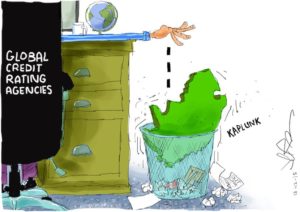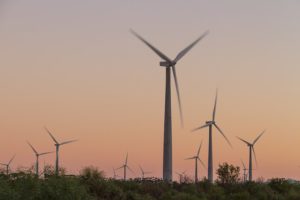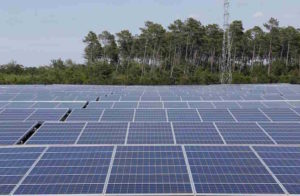SEPTEMBER 11, 2017
LONDON — British media is today full of praise for offshore wind farms, forecasting that their cost advantage exposed in the latest Government subsidy auction sounds the death knell for the UK’s controversial Hinkley Point nuclear plant. Offshore windfarms are now coming in at £57.50 per MWh, half the level of Government guarantee required in the auction two years ago. Hinkley Point requires a guaranteed price of £92.50 per MWh from Westminster. But there are two sides to every story. And in this well argued contribution, economist Rob Jeffrey presents the case against windfarms, specifically in South Africa – and, by definition, the case for nuclear and coal. He makes the case in the context of an electricity equation which has gone horribly awry – and an economy which he warns is on the brink of repeating the disaster of Venezuela. – Alec Hogg
By Rob Jeffrey*
The future GDP growth in South Africa is set to be pedestrian at best with the potential of serious recession, increasing poverty and political instability hovering like a dark cloud on a not too distant horizon.

Rob Jeffrey
One would think government, state-owned enterprises and business would work together to ensure this looming disaster is avoided. To date this has not happened.
The reason for this gloomy outlook is easy to identify – insufficient domestic and foreign real investment in enterprise and business. Stock market transactions do not count. Real foreign direct investment has declined massively in recent years. The origins of this malaise are not difficult to find.
Policy uncertainty
Firstly, there is a complete lack of confidence caused by political and economic policy uncertainty.
South Africa occupied the 11th position out of the top 25 rated countries in the AT Kearney Foreign Direct Investment (FDI) Confidence index in 2012, it has in 2016 dropped to the 25th position.
South Africa’s has also declined on the 2017 Fragile States Index. Ten years ago, South Africa was ranked in the stable category, but now falls in the elevated warning category – A snapshot of the ten-year trend shows that only Libya, Syria, Yemen and Mali have had a worse marginal change.
It is hardly surprising that the three key ratings agencies S&P, Moody’s and Fitch have all downgraded South Africa and have it on a negative watch. State capture and corruption rank high on the list.
According to the Minister of Economic Development, Ebrahim Patel, corruption costs the SA gross domestic product (GDP) at least R27bn annually as well as the loss of 76 000 jobs that would otherwise have been created.
 

More magic by top cartoonist Jeremy available at jerm.co.za.
But, the problems run far deeper.
The list includes the potential implementation of the mining charter, the threat of interference in the independence of the SA Reserve Bank, a host of often well-meaning but damaging regulatory laws that interfere in various markets ranging from labour through to purchasing and investment policies. These often foster corruption and hamper market efficiency and effectiveness.
Finally, there are attacks on “white capitalism”. And then there is a long list of poorly performing state-owned enterprises which are absorbing money but in most instances with no real plans to solve their problems. The government has insufficient funds to finance infrastructure development and extensive growth itself. Apart from corruption the country is being bled dry by these ailing state-owned companies requiring bail-outs.
Why does the government not privatise some of them or form genuine arms-length (i.e. no buddies) public-private partnerships?
For example, why does South Africa persist in trying to run the ailing South African Airlines (SAA)? Yes, it is a flag bearer but it is time to realise private ownership by some other carrier would be a realistic solution. It could still bear the name SAA. It is time to put national ego aside and do the right thing.
High electricity price increases
Secondly, the country has faced years of high electricity price increases.
The sound move to introduce cost reflective tariffs is one reason. The equally important necessity to consider the replacement cost of new build programmes is another.
However, both are driven by the high cost of inefficiencies in new build programmes and in the organisation caused in part by the policy factors, including corruption and imperfect government policies, indicated above.
South Africa needs to improve its efficiency and compare its cost structures with those in other resource rich countries.
One example could be Australia where a recently released independent report by power sector engineers and advisers GHD and Solstice Development Services entitled “HELE Power Station Cost and Efficiency Report” estimated a current construction cost in Rand equivalent at R22.7m per MW for a modern HELE or ultra-super critical (USC) coal plant.
It estimated generation cost at the Rand equivalent of between R412.8 per MWh to R804.96 per MWh (2017 prices) on a long run marginal cost basis, which includes achieving a return and meeting capital and operating expenses. In comparison with, if numbers were directly compared, Kusile estimated construction costs would be R109 billion compared to R213 billion.
 

An Eskom Generation sign sits on display at the Grootvlei power station, operated by Eskom Holdings SOC Ltd., in Grootvlei, South Africa. Photographer: Dean Hutton/Bloomberg
Generation costs would be between 41.3cents/kWh and 80.5 cents/kWh compared to Kusile estimates running at about R1.20/kWh. This is for power generation over 80% of the time and is therefore far cheaper than wind and solar at 65cent/kWh but for less than 35% of the time.
It is not possible to transpose directly these figures to South Africa, but when the difference in construction costs is almost 100% or double in South Africa and generation cost is at least 50% and possibly three times higher, then something is undoubtedly amiss. Clearly construction and operating efficiencies are not up to standard and need to be closely investigated.
The point being it is not the technology that is at fault. It is efficiency.
Econometrix did a study in 2010 on the impact of electricity price increases on future economic growth. The modelling was done by the late great Tony Twine, an outstanding and realistic economist of his era.
It should be remembered that at the time, the country already had had substantial price increases over the previous two years of more than 20% a year.
It was estimated that for the period 2010 to 2018, further real electricity price increases over the period of 84% would decrease economic growth by 1.5% per annum from a base case of 3.5% per annum to an estimated 2.0% per annum.
The potential increase in employment over the period would decrease from 5.8 million to 1.6 million. The impact on the mining and manufacturing sectors would be particularly devastating.
Reality has confirmed these figures. The real price increase of electricity has been close to the above forecast. GDP growth for the period from 2009 to 2016 has averaged 2% per annum with an employment increase of only 1.59 million.
In fairness, other well-meaning but economically damaging policies have exacerbated the figures. Planned future high increases are possibly the final nail in the coffin for many key industries.
Flawed electricity generation policy
The third major problem is South Africa’s defective planned electricity generation policy. This is based on the belief that future base load electricity can be supplied by renewables, primarily wind.
A report entitled ‘Critical Review of The Levelised Cost of Energy (LCOE) Metric’, by M.D. Sklar-Chik et al published in the South African Journal of Industrial Engineering December 2016 is relevant. It concluded that “LCOE neglects certain key terms such as inflation, integration costs, and system costs.”
Many international reports prove that such electricity supply is extremely expensive due to its variability, interruptibility, inefficiency and its requirement of 100% backup.
Read also: Rob Jeffrey: Renewables not SA’s panacea – time to put country first
Another study by B.P. Heard et al entitled a ‘Burden of proof: A comprehensive review of the feasibility of 100% renewable-electricity systems’ concluded that “there is no empirical or historical evidence that demonstrates that such systems are in fact feasible”.
They also reviewed the CSIR proposals regarding the high-penetration renewables in South Africa. The study concluded “both the use of the terms ‘technically feasible’ and the attempted costing of the proposed system are inappropriate and premature”.
Furthermore “a policymaker could have little doubt that the electricity demand proposed by the high-penetration renewable scenario from CSIR is not realistic and not in keeping with the imperative of alleviating wide-spread poverty in South Africa.”
This is supported by reality on the ground in every single country or state that has substantially increased its supply of this source of electricity.
Fritz Vahrenholt in his study entitled ‘Germany’s Energiewende: A Disaster in the Making’ sums up the situation. “It will take a long time to repair the severe damage caused by a misled energy policy”.

Gouda wind facility, Drakenstein Municipality, Western Cape.
In 2016, it must be noted that the prices paid by industry in Germany were 52% higher than France (nuclear) and 86% higher than Poland (coal). In Ireland, often given as an example of the success of wind power, the equivalent comparisons were 34% higher compared to France and 64% higher compared to Poland. On average Germany’s price of electricity appears to be 44% higher than the average electricity price in Europe.
South Australia evidently pays some of the highest electricity prices in the world. Numerous experts have concluded that wind can never be a major source of electricity power sufficient to drive economic growth in emerging and industrialising economies.
Essential reading includes a research report by D. Weißbach et al (2013) on energy returned from energy invested (EROI) in Germany. The research shows that renewables are uneconomic and will lead to economic stagnation. Whereas the EROI of coal and nuclear are in territory that fosters growth.
It certainly is a fact that all major economies with fossil fuel reserves are substantially increasing their electricity supply from these resources, including India, China, the Asean countries, Poland and now the United States.
Environmental Issues
Fourth, genuine environmental groups are becoming aware of the looming environmental catastrophe windfarms pose. Wind energy’s impacts on birds in South Africa, In Birdlife South Africa Occasional Report Series is one reference and “strategic environmental assessment for the wind and solar photovoltaic energy in south Africa” (2015)” (SEA) is another. Nine game reserves and nature reserves and other environmentalists were party to this submission.
Birdlife South Africa, Vulpro and other environmental groups have also objected to ill-considered windfarm developments and their effects on birdlife. Another reference is “Objection to Environmental Application for The Spitskop West Wind Energy Facility, Eastern Cape Prepared by ADS Environmental Consultants. Objections have, until recently, generally been on specific windfarm developments.
In a study of the Effect of Wind Turbines on Bird Mortality Maeve White November 24, 2016 found that in the USA killed 4 birds per MW in the total USA and 16 or more birds per MW in in California.
These figures were confirmation of an earlier study by Scott R. Loss, Tom Will, Peter P. Marra entitled “Estimates of bird collision mortality at wind facilities in the contiguous United States”. If these average numbers were aggregated over the full envisaged area affected in South Africa of over 100 000 square kilometres and over 100 000 MW as envisaged multiplied by the years then the number of birds lost per annum would be at least 400 000 per annum and over 8 million over the 20-year life of these windfarms.
There are various studies disagreeing with this and pointing to damage by fossil fuels. Notwithstanding that, irreplaceable bird species and other lifeforms to be lost by largescale windfarms will become devastatingly significant.
Read also: Renewable energy plans: Who’s in control? Eskom or govt?
Some argue that domestic cats kill an enormous number of birds per year but it would be hard put for these environmental enthusiasts to find any domestic cat killings of eagles, vultures, cranes, owls let alone the fairly domesticated hadeda. Rather the tables are more often the reverse where cats and small dogs are known to be carried off by birds of prey.
Many rare large birds could face extinction because of windfarms, which, apart from having obvious important ecological impacts, could also threaten some aspects of the tourist industries amongst others.
Education and skills
Finally, and most importantly, the government needs to improve the educational system. It is necessary that skills are upgraded to a point that youth have the educational and importantly the vocational skills necessary to meet the requirements of a modern industrialising economy. Without this all plans for achieving high economic growth are pointless. This subject is however not the focus of this article.
Mistaken investment strategies
The critical issue must be to concentrate on creating sustainable high economic growth.
South Africa must stop cutting the cake and start baking it. This is the only way South Africa can meet its key objectives of reducing unemployment, poverty and inequality and raising the standard of living of all South Africans.
Much is made by some economists and government that the future lies in fostering entrepreneurial enterprise. However, most entrepreneurial start-ups fail. Large projects and medium to large enterprises bring with them the finance and skills necessary to build solid foundations for future growth. They can provide the stability, leadership and mentorship so necessary for economic growth and transformation for smaller entrepreneurial businesses to prosper and grow.
Unfortunately, the delusion regarding renewable power sources is supported by many major business entities including financial institutions. These larger institutions are leading South Africa into a low economic growth energy strategy based on incorrect assumptions.
There are many sound environmentally friendly and green backed actions that are vitally necessary. Wind energy is not one of them. Instead there are vested financial and idealistic interests that effectively encourage financial institutions to offer their clients, including major provident and pension funds, investments in wind farm developments.
 

A general view shows solar panels used to produce renewable energy at the photovoltaic park in Cestas, France.
These investments offer exceptionally high returns, escalating with inflation, and most importantly government guaranteed returns on their investment. This is as good as or better than an investment in government guaranteed index linked bonds. However, these institutions do not seem to realise that this will ensure slow economic growth for South Africa and in the end slow growth for their very own institutions.
Furthermore, the high returns in fact will be subsidised by other electricity users. In effect, they are a tax on the poor. South Africa needs to urgently reindustrialise and at the same time ensure that the mining industry does not collapse but grows.
Amongst other policy requirements mining, manufacturing and industry need security of supply of electricity at competitive prices. The only two electricity generation sources of energy that can achieve these objectives in this country are clean or HELE (High Efficiency Low Emissions) coal and nuclear.
The discounted value of coal reserves is more than a trillion Rand. The value of Uranium reserves is probably equal to this. The discounted future value of these flows is over R250 000 per person of the available work force. It is enough to build 2 million more than adequate houses sufficient to house over 10 million people.
Read also: Chris Yelland: No end in sight to Eskom’s renewable energy delays
Those desiring the renewable route essentially are recommending leaving this treasure trove of natural resources in the ground, permanently throwing these benefits away and denying South Africa’s future generations their natural inheritance whilst at the same time effectively imposing a tax on the poor.
Renewables, despite the protestations of many so-called environmentalist, are not capable of driving reindustrialisation and creating conditions suitable for high economic growth. HELE coal plants are relatively clean. There is a 50% reduction in Carbon dioxide emissions.
In any event CO2 is not the environmental disaster the ideologists claim. There is substantial research on this subject by world renowned experts supporting this view. Amongst many others, including Dr Patrick Moore, co-founder of Greenpeace and Dr James Lovelock, proposer of the Gaia Hypothesis, the well-known author Paul Driessen believes Eco-Imperialism is being forced on the world by extreme environmentalists who are driving the world, particularly emerging economies, into poverty.
Conclusion
The five issues above are forcing major multinational corporations to review potential investment projects in South Africa.
One must ask what substantial international business in energy intensive industries would invest in a country where there is uncertainty regarding entitlement, energy supplies becoming less certain, electricity prices potentially rising excessively and, in addition, where there is a requirement to sell off and effectively finance between 30% and up to a 51% shareholding to BEE partners.
In addition, if their new BEE partners decide, to take a profit or for other sound reasons, sell, the shareholder supplying most of the skills and financial resources is required to repeat the process.
There are regulatory and labour problems together with other difficulties yet to be added to the list.

Flag of Venezuela
The above fully explains South Africa’s current predicament and slow growth forecast. South Africa stands on the brink of a Brazilian or Chavez Venezuelan style decline.
The purpose of this exercise is not to spread gloom and doom. It is to find a way out of this mess. The question for all South Africans is, are we prepared to make a clean break with immediate past policies and move the country towards a brighter future for all? This will take radical change.
It is time for South Africa to put its anti-capitalistic stance behind it and create the necessary conditions for future growth and prosperity by genuinely fostering domestic and foreign investment by supplying a common vision which all stakeholders can share and work together to achieve.
Rob Jeffrey is a managing consultant and senior economist at Econometrix. He writes this in his personal capacity.
SA on brink of Venezuelan-style economic decline. Here’s five reasons why.

